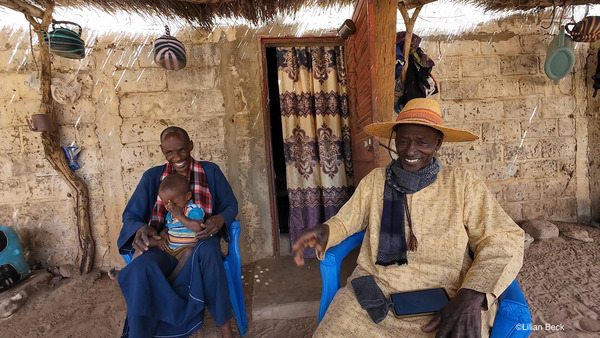It is the windy, dry season in Senegal, Ouarkhokh, one of our project sites, with the most challenging soil. It seems impossible to plant and maintain young and vulnerable tree seedlings in the desert-like sandy soil here. But to our surprise, one of the project model farmers guides us to a lush agroforestry garden in which healthy green pepper seedlings are thriving under the canopies of trees. Among them are local trees called Faidherbia Albida and Khaya senegalensis, Moringa, often called a miracle tree because of its rich nutrients, and fruit trees such as Papaya. It is a garden managed by a women's group, one of them being our innovative platform member, Ndeye. So then we seize the moment and ask her the question that has been weighing on our minds:
How can one cultivate vulnerable crops such as peppers in the midst of the dry season on such sandy soil?
Ndeye, a female farmer, explains to us the importance of trees in protecting her crops from heat extremes and wind. She observes that the trees are creating a suitable microclimate. The agroforestry garden is managed smartly using the little water they have effectively: Drip irrigation combined with compost. Compost is added around the crops to preserve the humidity and nourish them. This is a technique she learnt in the Innovation Platform meetings of Sustain Sahel. "If farmers don't have trees on their farms, they need to plant them!" But how did she manage to grow trees in these harsh conditions? She shows us her on-farm tree nursery and agrees to produce a video tutorial with us to share her best practices with other farmers.
But she is not the only farmer we met during our video production who inspired us with her agroforestry practices.
There is Diop Thiam who shows us how he maintains tree seedlings in the sandy soil by using mulch and manure, there is Sokhna Faye who shows us how she uses the shrub Guiera combined with a diversity of animal droppings to create a nutrient rich compost, and few farmers who explain techniques to multiply trees and shrubs such as Faidherbia and Guiera using the very successful assisted natural regeneration practices. These are some examples of the rich knowledge Lilian Beck (Uni Hohenheim), Dr. Diara Sylla (CSE), and Ameth Fall (CSE) experienced during their video production with project model farmers in Senegal. In February, during the Innovation Platform meetings held in Ouarkokh and Niakhar, Senegal, which were organized by Michael Diédhiou at CNCR, several videos were screened. This provided farmers with the opportunity to discuss the practices showcased in the videos.
Watch the video 'Propagation of trees on field in Senegal' on YouTube, in French.
We invite you to watch all of our videos to learn more about agroforestry best practices from our lead farmers, including Ndeye.
Currently, more videos are being edited. These videos will soon be available on the SustainSahel YouTube channel.




 tap and then scroll down to the Add to Home Screen command.
tap and then scroll down to the Add to Home Screen command.